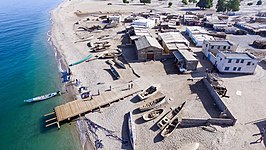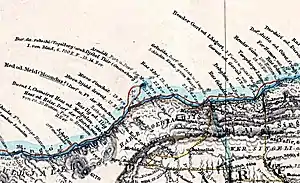Maydh
Maydh (also transliterated as Mait or Meit) is an ancient port city in the eastern Sanaag region of Somaliland.
Maydh | |
|---|---|
Town | |
  The tomb of Sheikh Isaaq the father of the Isaaq clan, and the waterfront of Maydh town | |
.svg.png.webp) Maydh Location in Somaliland . | |
| Coordinates: 11°00′18″N 47°06′36″E | |
| Country | |
| Region | Sanaag |
| Time zone | UTC+3 (EAT) |
History
Antiquity

According to Augustus Henry Keane, Maydh represents an early center of dispersal of the Somali people. National genealogies collected by the scholars Cox and Abud assert that many clan patriarchs are buried in or nearby the town.[1]
Medieval
The city of Maydh was home to Sheikh Isaaq Bin Ahmed Al Hashimi (Sheekh Isaxaaq), who, according to tradition, moved to Somaliland from the Arabian Peninsula in the 12th or 13th century CE. He is considered to be the founding father of the large Isaaq Somali clan that predominantly inhabits Somaliland, as well as parts of Djibouti and Ethiopia. Sheikh Isaaq's domed tomb is also located here.[2]
Legendary 15th century Arab explorer Ahmad ibn Mājid wrote of Maydh and several other notable landmarks and ports of the northern Somali coast, including Berbera, the Sa'ad ad-Din islands (aka the Zeila Archipelago near Zeila), Alula, Ruguda, Heis, El-Darad and El-Sheikh.[3]
Somaliland in general is home to numerous such archaeological sites, with similar edifices found at Haylaan, Qa’ableh, Qombo'ul and El Ayo. However, many of these old structures have yet to be properly explored, a process which would help shed further light on local history and facilitate their preservation for posterity.[4]
Portuguese navigator Duarte Barbosa described the Somali coast and noted Met (Maydh) as a town with an abundance of meat but little trade. This would indicate that Maydh was likely a pilgrimage site where travelers would come to pray.[5]
Early Modern
Maydh shares many similarities with nearby Heis the Habr Yunis attained a lot of frankincense in the mountains south of Maydh. Arab and Banyan merchants would visit the port before continuing on to the western Somali coast.[6] Maydh was the preeminent export point for large hides in eastern British Somaliland and came second in the total quantity of skins exported after Heis with over 15,000 being shipped out. The town had dialogue with Berbera with a large amount of cross trade occurring usually by dhow and the largest commodity being livestock.[7]
Modern
The town is now mostly fishing oriented with the large Asli Maydi company harvesting frankincense trees across Sanaag with significant exports. In 2020 the British, Dutch and Norwegian missions announced the start of a jetty in Maydh to bolster economic activity and construction is in progress.[8]
References
- A.H. Keane, Man, Past and Present, (Cambridge University Press: 1920), p.485.
- I.M. Lewis, "The Somali Conquest of the Horn of Africa", Journal of African History, 1 (1960), pp. 219-220
- "Ibn Majid". Medieval Science, Technology, and Medicine: An Encyclopedia. Routledge. 2005. ISBN 978-1-135-45932-1.
- Michael Hodd, East African Handbook, (Trade & Travel Publications: 1994), p.640.
- Barbosa, Duarte (1866). A Description of the Coasts of East Africa and Malabar in the Beginning of the Sixteenth Century (translated). Hakluyt Society. p. 17.
- Pankhurst, Richard (1965). "The Trade of the Gulf of Aden Ports of Africa in the Early Nineteenth and Early Twentieth Centuries". Journal of Ethiopian Studies. 3 (1): 36–81. JSTOR 41965718.
- Great Britain, House of Commons (1905). Sessional papers Inventory control record 1, Volume 92. HM Stationery Office. p. 391.
- UK, Gov (5 July 2020). "UK, Denmark and Netherlands approve agreements with Somaliland Government on critical infrastructure to improve people's lives".
